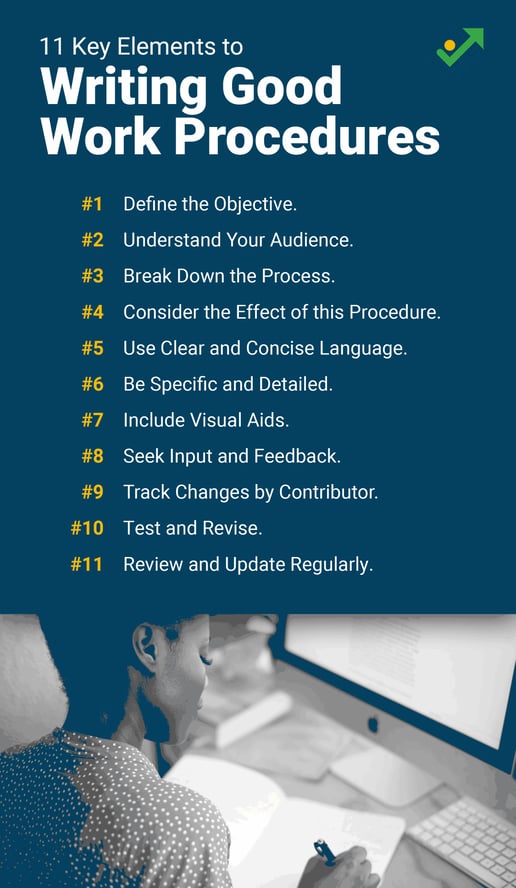
In any organization, well-written and well-communicated work procedures are crucial for ensuring consistency, efficiency, and quality in day-to-day operations. Whether you are a manager, a team leader, or an individual contributor, writing good work instructions and procedures is an essential skill. In this blog post, we will explore 11 keys to help you create effective work procedures that are clear, actionable, and easy to follow.

Before diving into writing a work procedure, clearly define the objective you want to achieve through the procedure. What specific task or process are you documenting? Understanding the purpose of the procedure will help you outline the necessary steps, keep the document focused, and avoid scope creep.
It’s very important to have a clear goal and include a purpose statement in your writing process. Studies show that when people know why they should do something, they are more apt to do it, and do it correctly. It is not unusual for multiple managers or subject matter experts to be involved in writing a procedure. Having a clearly defined purpose statement will help the contributors remain focused.
Think about your readers, the people who will be putting your procedure into practice. What are their backgrounds? What does their daily workflow include? Why are they reading this procedure? Are they onboarding as a new hire, or did something go wrong?
Break down the task or process into smaller, manageable steps. Begin with a high-level overview and gradually delve into the details. This approach makes complex procedures more accessible and ensures that nothing is overlooked. You may find that the steps should be broken out into separate procedures for separate roles.
Think about the procedure for onboarding new employees. Human Resources (HR) has the responsibility to communicate with the new hire, gather paperwork, and explain benefits. HR also needs to alert IT about a new employee so that IT can set up the email address, order equipment, set up software credentials, etc. In this case, HR and IT would have separate new hire procedures to follow.
Zavanta, our policy and procedure software, utilizes guided authoring to help your team write standard operating procedures. The system prompts the procedure writer, ensuring that they provide the information that procedure users need, in the order they need it. Below is the critical list of questions that need to be answered in every procedure:
One of the benefits of having good procedures is more effective operations. Actions from one task owner can impact the work of another person if not done properly. Warnings and precautions may be included. Additional related procedures may need to be written.
Consider a restaurant scenario for procedures in clearing a table. Defining step-by-step instructions for the ideal way to load a bus tub can have implications on multiple areas of the business.
Good work procedures should be easy to understand and follow. With technical writing, use active voice and plain language and avoid jargon or technical terms that may confuse the reader. Instead of saying “circle back to your supervisor,” speak with your supervisor or schedule an update with your supervisor.
Keep sentences and paragraphs short when writing work instructions. Use numbered or bullet point lists to highlight steps or important information. Increase the font size and use bold section headers to make it easier to read. Sometimes the formatting of the process documents and job aids can make it easier to scan, understand, and use.
Zavanta, our policy and procedure management software, allows you to set the formatting for all your work processes. Once you enter all of the details, steps, and information, you can create a consistent format for Word documents with the click of a button.
Provide clear instructions for each step in the procedure. Include relevant information such as required tools, materials, or software. Consider potential variations or exceptions that may arise and address them in the procedure. Or consider writing a separate procedure for exceptions. The more specific and detailed the instructions, the easier it will be for the reader to execute the task correctly and efficiently.
For example, in an industrial laundry facility, the procedure for loading the washing machine could include clear work instructions to manually reach into the corners of the machine to fill the gaps. An average worker may fit five laundry bags into the machine. By taking an extra minute to push the laundry into the gaps of the machine, a worker may fit seven to eight laundry bags and finish the wash much more quickly. (Note, this story is from my experience working on a cruise ship and working on linen detail.)
Writing work procedures should not be an isolated task. Involve the people who perform the task regularly or are subject matter experts. Seek their input and feedback to ensure the procedure accurately reflects the best practices and incorporates their valuable insights. The collaboration will lead to more comprehensive and reliable work procedures.
We have several clients who are growing quickly through acquisition. They are consolidating SOPs and policies and procedures from all acquired companies. Subject matter experts are evaluating procedures across all the groups to identify best practices and share key learnings. Our Zavanta system is making this process much more efficient, as all collaborator activity is properly documented.
Zavanta, our policy and procedure management tool, offers our clients version control and revision management with a history log that shows who made changes, when the changes were made, revision notes, and more.
You may need to establish a hierarchy of approvers. It’s common for reviewers to have conflicting opinions and make changes to previous changes. Designate a specific subject matter expert to have the final opinion.
Once you have drafted and published the work procedure, the best way to test is in real-world scenarios. Implement it and observe its effectiveness. Pay attention to any challenges, human error, or confusion that arise during execution. Ask for feedback from your user audience. Based on the feedback and observations, revise and refine the procedure as necessary to make it more robust and user-friendly.
To test your procedure, try simulating the environment with your team members who will perform the task. Follow the written procedure word-for-word to perform the task. Make notes of any problems, missing or confusing information, or additional steps.
An example from the manufacturing industry involves using a QR code on a specific piece of machinery. An employee scans the QR code with their mobile device to access the specific steps in the manufacturing process they want to test. This allows for the data to be tracked and analyzed.
Work procedures should not be static documents. As processes evolve, technologies change, or new best practices emerge, it is essential to review and update the procedures regularly. Schedule and allocate time to assess the relevance and effectiveness of existing procedures and make necessary revisions to ensure they remain accurate and up to date.
Writing effective procedures is a skill that can significantly enhance productivity, efficiency, and consistency in any organization. By following these key elements, you can create procedures that are clear, actionable, and easy to follow. With these guidelines in mind, you will be well-equipped to create effective work procedures that allow your team to work more efficiently, make fewer mistakes, and reduce risk.
Comprose clients using Zavanta, our policy and procedure software, have the advantage of writing their work procedures in a system that automates the full life cycle. Everything mentioned in this article is included in our system. Please contact us to learn more.
Additional Resources
11 Key Elements to Writing Good Work Procedures

1. Define the Objective.
Before diving into writing a work procedure, clearly define the objective you want to achieve through the procedure. What specific task or process are you documenting? Understanding the purpose of the procedure will help you outline the necessary steps, keep the document focused, and avoid scope creep.
It’s very important to have a clear goal and include a purpose statement in your writing process. Studies show that when people know why they should do something, they are more apt to do it, and do it correctly. It is not unusual for multiple managers or subject matter experts to be involved in writing a procedure. Having a clearly defined purpose statement will help the contributors remain focused.
2. Understand your Audience.
Think about your readers, the people who will be putting your procedure into practice. What are their backgrounds? What does their daily workflow include? Why are they reading this procedure? Are they onboarding as a new hire, or did something go wrong?
- Before you begin writing work guides and procedures, do you understand things like:
- How much or how little do they already know about the task at hand?
- Do they know how to do part of the task, but need a refresher or need to double-check how to do it?
- Have you observed common distractions in their work environment?
- What is their reading ability? Is English their second language? Do you require translations?
- Does everyone have access to the same resources
- Do they have time constraints
- What are their common problems?
3. Break Down the Process.
Think about the procedure for onboarding new employees. Human Resources (HR) has the responsibility to communicate with the new hire, gather paperwork, and explain benefits. HR also needs to alert IT about a new employee so that IT can set up the email address, order equipment, set up software credentials, etc. In this case, HR and IT would have separate new hire procedures to follow.
Zavanta, our policy and procedure software, utilizes guided authoring to help your team write standard operating procedures. The system prompts the procedure writer, ensuring that they provide the information that procedure users need, in the order they need it. Below is the critical list of questions that need to be answered in every procedure:
- Description (What is the task?)
- Purpose (Why do it?)
- Who is responsible? (Who does it? Does it apply to me? Who's involved?)
- How often is the procedure performed? (When do I do this job?)
- Can I do this job? (What do I need before I start?)
- Is approval required?
- Required equipment or material
- Warnings or safety precautions
- Procedure steps (How do I do each step?)
- Troubleshooting (What do I do if something goes wrong?)
4. Consider the Effects of this Procedure.
One of the benefits of having good procedures is more effective operations. Actions from one task owner can impact the work of another person if not done properly. Warnings and precautions may be included. Additional related procedures may need to be written.
Consider a restaurant scenario for procedures in clearing a table. Defining step-by-step instructions for the ideal way to load a bus tub can have implications on multiple areas of the business.
- Cost savings. Clearing glassware in a separate bus tub can minimize breakage and speed up the process for the dishwashers.
- Avoid illness. Directing staff to avoid touching the rim of the glass (where the guests put their mouth) when they clear can prevent the spread of germs.
- Improve efficiency. Organizing the bus tub as you clear the table can help the dishwashing team work more quickly, loading and unloading the dish racks with like items. Stacking plates in one corner, scraping food in another corner, while grouping the silverware in an opposite corner is more efficient than a random pile of dishes
5. Use Clear and Concise Language.
Good work procedures should be easy to understand and follow. With technical writing, use active voice and plain language and avoid jargon or technical terms that may confuse the reader. Instead of saying “circle back to your supervisor,” speak with your supervisor or schedule an update with your supervisor.
Keep sentences and paragraphs short when writing work instructions. Use numbered or bullet point lists to highlight steps or important information. Increase the font size and use bold section headers to make it easier to read. Sometimes the formatting of the process documents and job aids can make it easier to scan, understand, and use.
Zavanta, our policy and procedure management software, allows you to set the formatting for all your work processes. Once you enter all of the details, steps, and information, you can create a consistent format for Word documents with the click of a button.
6. Be Specific and Detailed.
Provide clear instructions for each step in the procedure. Include relevant information such as required tools, materials, or software. Consider potential variations or exceptions that may arise and address them in the procedure. Or consider writing a separate procedure for exceptions. The more specific and detailed the instructions, the easier it will be for the reader to execute the task correctly and efficiently.
For example, in an industrial laundry facility, the procedure for loading the washing machine could include clear work instructions to manually reach into the corners of the machine to fill the gaps. An average worker may fit five laundry bags into the machine. By taking an extra minute to push the laundry into the gaps of the machine, a worker may fit seven to eight laundry bags and finish the wash much more quickly. (Note, this story is from my experience working on a cruise ship and working on linen detail.)
7. Include Visual Aids.
Visual aids, such as diagrams, flowcharts, or photographs, can significantly enhance the clarity of work procedures. Visual representations help readers visualize the process and understand the relationships between different steps. They can also serve as quick references during execution.
Examples might include:
- Screenshots from software programs and business systems
- Videos that demonstrate a specific step
- Illustrations, diagrams, or flowcharts
- Photographs of machinery
8. Seek Input and Feedback.
Writing work procedures should not be an isolated task. Involve the people who perform the task regularly or are subject matter experts. Seek their input and feedback to ensure the procedure accurately reflects the best practices and incorporates their valuable insights. The collaboration will lead to more comprehensive and reliable work procedures.
We have several clients who are growing quickly through acquisition. They are consolidating SOPs and policies and procedures from all acquired companies. Subject matter experts are evaluating procedures across all the groups to identify best practices and share key learnings. Our Zavanta system is making this process much more efficient, as all collaborator activity is properly documented.
9. Track Changes by Contributor.
Zavanta, our policy and procedure management tool, offers our clients version control and revision management with a history log that shows who made changes, when the changes were made, revision notes, and more.
You may need to establish a hierarchy of approvers. It’s common for reviewers to have conflicting opinions and make changes to previous changes. Designate a specific subject matter expert to have the final opinion.
10. Test and Revise.
Once you have drafted and published the work procedure, the best way to test is in real-world scenarios. Implement it and observe its effectiveness. Pay attention to any challenges, human error, or confusion that arise during execution. Ask for feedback from your user audience. Based on the feedback and observations, revise and refine the procedure as necessary to make it more robust and user-friendly.
To test your procedure, try simulating the environment with your team members who will perform the task. Follow the written procedure word-for-word to perform the task. Make notes of any problems, missing or confusing information, or additional steps.
An example from the manufacturing industry involves using a QR code on a specific piece of machinery. An employee scans the QR code with their mobile device to access the specific steps in the manufacturing process they want to test. This allows for the data to be tracked and analyzed.
11. Review and Update Regularly.
Work procedures should not be static documents. As processes evolve, technologies change, or new best practices emerge, it is essential to review and update the procedures regularly. Schedule and allocate time to assess the relevance and effectiveness of existing procedures and make necessary revisions to ensure they remain accurate and up to date.
Writing effective procedures is a skill that can significantly enhance productivity, efficiency, and consistency in any organization. By following these key elements, you can create procedures that are clear, actionable, and easy to follow. With these guidelines in mind, you will be well-equipped to create effective work procedures that allow your team to work more efficiently, make fewer mistakes, and reduce risk.
Comprose clients using Zavanta, our policy and procedure software, have the advantage of writing their work procedures in a system that automates the full life cycle. Everything mentioned in this article is included in our system. Please contact us to learn more.
Additional Resources




